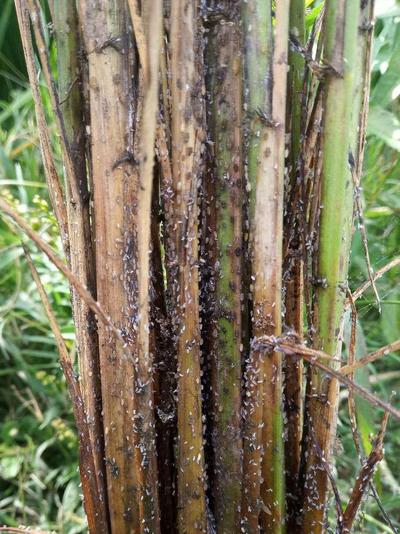Brown Planthopper
Nilaparvata lugens
Insect
In a Nutshell
- Small planthoppers on sheaths of the plants.
- Initially orange-yellow, later brown and dry leaves.
- Wilting and yellowing of plants.
Can also be found in
Symptoms
Both nymphs and adults take refuge at the base of the plant and suck sap from stems and leaves. Plants wilt and start to yellow. High population density can cause leaves to first turn orange-yellow, then become brown and dry (hopper burn), and eventually, the plant dries up and dies. In the field, symptoms are first visible in small patches but they can grow rapidly as the planthoppers spread. Females lay eggs in stems and midvein of leaves, causing additional damage. Production of honeydew leads to the growth of sooty molds. Plants have smaller panicles, fewer ripened grains, and lower grain weight.
Recommendations

Organic Control
Biological treatments can be used at low population densities of the pest. Natural enemies of the brown planthopper include water striders, mirid bugs, spiders, and various egg parasitoids wasps and flies. The insect can be held in check by flooding the seedbed, for a day, so that only the tips of seedlings are exposed (drowning). Alternatively, small seedbeds can be swept with a net to catch the insect.

Chemical Control
Always consider an integrated approach with preventive measures together with biological treatments if available. Insecticides are only recommended if critical numbers are found, or if more planthoppers than natural enemies are observed. Insecticides that can be used against the pest include buprofezin, pymetrozine, etofenprox, or alternating compounds. Avoid the usage of chemicals like quinalphos, chlorpyriphos, or lambda-cyhalothrin or other synthetic pyrethroid combinations that favor the development of resistance and the resurgence of the insect.
What caused it?
Damage is caused by the brown planthopper, Nilaparvata lugens. It can be a problem in rain-fed and irrigated wetland environments, areas with continuous submerged conditions in the field, high shade, and humidity. The closed canopy of the rice plants, densely seeded crops, excessive use of nitrogen, and early season insecticide spraying (that destroys natural enemies) also favors insect development. Brown planthoppers are usually more abundant in the dry season than in the wet season. Insects can be monitored by bending over the plants slightly, and gently tapping them near the base, to see if planthoppers fall onto the water surface.
Preventive Measures
- Use locally recommended resistant varieties, if available.
- Plant fields of a same area at the same period to avoid outbreaks.
- Allow alleyways of 20 cm for every 2 meters in east-west direction during kharif and north-south direction in rabi.
- Look for insects daily in the seedbed or in the field, on stems and the water surface.
- Sweep small seedbeds with a net to catch the insect.
- Remove weeds from the field and surroundings regularly.
- Avoid overdosing nitrogen applications.
- Use light traps (5/acre) such as electric bulbs or kerosene lamps near a light colored wall or over a pan of water.
- Additionally install 20 yellow sticky traps.
- Avoid the use of non-selective insecticide to favor beneficial insects.
- Adopt alternate wetting and drying of the field to drown the insect.



